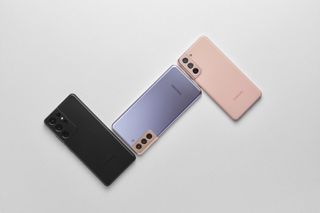Samsung Galaxy S21 first look: Contour of the Galaxy
A striking new camera design, but little change year-on-year with the S21 and S21+

While 2021 couldn't come soon enough, the year's first big flagship smartphone has arrived swiftly. Samsung's Galaxy S21 and S21+ are the first major launches of the year and follow on from last year's S20 range, which helped the firm break sales records in the third quarter of 2020.
Samsung Galaxy S21 Ultra first look: Big has never looked so beautiful Samsung Galaxy S20 Ultra 5G review Samsung Galaxy S21 might launch early in bid to fight Huawei
The launch of both handsets has reportedly been moved forward by two months to capitalise on weak Huawei sales. There are also rumours the company is concerned about increased competition in the market and the late release of the iPhone 12. As the (current) number one smartphone manufacturer, the pressure is on Samsung to deliver something special with the S21 and the S21+.
Samsung Galaxy S21 first look: Design
Samsung is proving to be quite shrewd with its designs, only changing little bits each year, but still somehow making them unique. For example, the most noticeable difference on the S21 from the S20 is the camera module, which now wraps around the top left-hand corner of the device. This has been dubbed the 'contour-cut', by the South Korean giant and, we have to admit, it looks much better than the bulky module on the S20.
The only other difference is the introduction of a new purple and gold colour scheme, 'Phantom Violet', which may be popular with fans of the Avengers as it looks like Thanos in smartphone form. As you would expect, the S21+ is considerably taller than the standard S21 at 161.5mm but only slightly wider at 75.6mm, and oddly slimmer at 7.8mm (the S21 is 7.9mm) - but, again, this isn't much different from the S20+.

Samsung Galaxy S21 first look: Display
The S21 comes with a 6.2in FHD+ Dynamic AMOLED display, which would again suggest little change year-on-year, if not for the support of a 120Hz refresh rate. That's a very premium feature for a standard model; it was on the Note 20 Ultra, but not the smaller Notes - it's also not on any of the current iPhones. Only Sony's Xperia 5II managed to match it, but it's worth noting that one of the few blemishes on last year's excellent S20 Ultra was the amount of power the 120Hz refresh rate sapped from its battery.
Screens are Samsung's forté and it makes them so well that other manufacturers frequently use them in their own devices. So when the company says that its new display produces 100% for gamut colour coverage, we tend to believe that to be the case. The only recent device to score less than perfect was the Note 20 Ultra, which just about managed to get above 93% for colour coverage and struggled with brightness levels. However, the display on last year's S20 was buttery smooth and resplendent - there's little to suggest the S21 won't be the same.
The S21+ has a 6.7in display but features the same screen specs as the S21, which may make it harder to justify the extra £200. While both promise high-quality displays, the same can still be said for last year's S20, which suggests there hasn't been that much improvement. The best assumption here is that the S20 was a very good smartphone, so Samsung has a high bar to clear. There's also the unavoidable issue of production and supply chain delays caused by the pandemic, so some improvement, no matter how incremental, is still impressive under the circumstances.
Get the ITPro. daily newsletter
Receive our latest news, industry updates, featured resources and more. Sign up today to receive our FREE report on AI cyber crime & security - newly updated for 2024.
Samsung Galaxy S21 first look: Specs and features
Samsung revealed its latest Exynos 2100 SOC in a separate event ahead of the launch. The new CPU has been built with a 5nm extreme ultraviolet process node - this is a type of lithography used to develop chips. Samsung is one of only two companies to use this method for production.
The chip is tipped by Samsung to improve multi-threaded performance by 30%. The S20 scored very well in Geekbench 5, hitting 2,779 and a 30% jump would push that well above 3,000. You would need to be an excessive power user to notice that improvement, however.
The processor will be matched with 8GB of RAM with either 128GB or 256GB of storage. We can also expect improvement with image editing and AI capabilities, but we can't elaborate on these until we get our hands on the device.

Samsung Galaxy S21 first look: Battery
As mentioned, some features could heavily impact the battery. Last year's S20 Ultra was notable for the draining 120Hz display. The S21 has a 4,000mAh battery, the same as the S20 which managed to last 18hrs 28 mins in our looped video test. The S21+ has gone slightly bigger, swapping the 4,500mAh battery in the S20 with a 4,800mAh one. There's no way to know what the effects will be like until we've given it a full test, however, although both models come with upgraded AI optimisation which Samsung claims will help users manage battery use.
Samsung Galaxy S21 first look: Camera(s)
Both the S21 and the S21+ house triple-camera setups. They feature a 12MP ultra-wide lens, a 12MP wide lens and a 64MP telephoto lens - plus a 10MP selfie cam. These are the same as the S20 and the S20+, but there are some software changes that may help Samsung edge ahead of Huawei, specifically when it comes to telephoto lenses.
Last year the South Korean giant launched its 'Space Zoom' and as with the P40 Pro, it offered users the ability to take shots from ridiculously long distances. The issue with these capabilities is how shaky the final photo can look, but Samsung's 'Zoom Lock' promises to fix that with stabilisation controls - potentially a game-changing feature.
Samsung Galaxy S21 first look: Early verdict
At face value, the £769 S21 and the £949 S21+ might not have enough new features to warrant an upgrade. It really depends on what you're comparing it to; if you have an older Samsung model or a lesser flagship phone it probably makes more sense. However, if you have last year's S20, you're really just upgrading to a sleeker camera design and that new purple colour. This is a great new Galaxy, but it feels a lot like one we've already visited.
Bobby Hellard is ITPro's Reviews Editor and has worked on CloudPro and ChannelPro since 2018. In his time at ITPro, Bobby has covered stories for all the major technology companies, such as Apple, Microsoft, Amazon and Facebook, and regularly attends industry-leading events such as AWS Re:Invent and Google Cloud Next.
Bobby mainly covers hardware reviews, but you will also recognize him as the face of many of our video reviews of laptops and smartphones.





